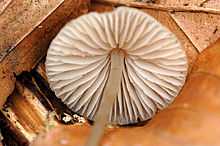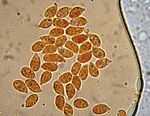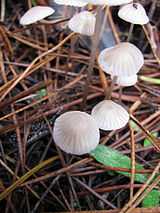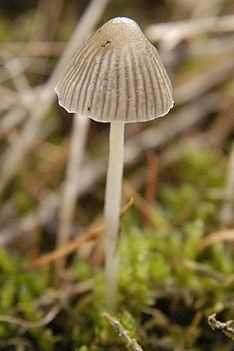Mycena leptocephala
| ||||||||||||||||||||||||||||||||||||||||||||||
Mycena leptocephala, commonly known as the nitrous bonnet, is a species of fungus in the Mycenaceae family. The mushrooms have conical grayish caps that reach up to 3 cm (1.2 in) in diameter, and thin fragile stems up to 5 cm (2.0 in) long. The gills are gray and distantly spaced. The spores are elliptical, typically measure 7–10 by 4–6 μm, and are white in deposit. When viewed under a light microscope, the gills has abundant spindle-shaped cystidia on the gill edges, but few on the gill faces. The mushroom is found in North America and Asia, where it grows singly or in groups on conifer needles, cones and sticks on the forest floor. It has a distinctive odor of bleach; the edibility is unknown. Similar species include Mycena alcalina, M. austera, and M. brevipes.
Taxonomy
The species was first called Agaricus leptocephalus by Christian Hendrik Persoon in 1800,[2] and was transferred to the genus Mycena in 1876 by French mycologist Claude-Casimir Gillet.[3] Synonyms include Agaricus alcalinus var. leptocephalus (Fries, 1821),[4] Mycena alcaline var. chlorinella (J.E. Lange, 1914),[5] and Mycena chlorinella (Singer, 1936).[6] The latter was reduced to synonym in a 1980 publication by Dutch Mycena specialist Maas Geesteranus.[7]
Mycena leptocephala is classified in the section Fragilipedes of the genus Mycena, along with other similar-looking mushrooms, such as M. aetites, M. austera, M. parca, and M. aronsenii. Some of these have a nitrous smell similar to M. leptocephala.[8]
The specific epithet leptocephala is derived from the Greek λεπτος leptos, "thin" and κεφαλη kephale, "head",[9] and refers to the delicate cap.[10] The mushroom is commonly known as the "nitrous bonnet".[11]
Description

The cap of M. leptocephala is 1–3 cm (0.4–1.2 in) in diameter, and initially a fat conical shape with the margin pressed close to the stem. As the cap expands, it becomes broadly conic to convex, sometimes broadly bell-shaped, and sometimes convex with a flaring margin. The cap surface has a whitish sheen because of its pruinose coating. The coating gradually sloughs off, leaving the surface smooth and moist. The cap shows radial grooves that outline the position of the gills underneath. Its color is initially dusky brownish-gray to blackish (after the pruinose coating has sloughed off), soon fading from dark to light gray and finally ashy-gray. The flesh is thin and fragile, grayish, and has a slightly sour (acidulous) taste, and a weakly alkaline odor that strengthens in intensity if the flesh is crushed. The gills are narrow, equal in width throughout, ascending-adnate (the gills attach at much less than a right angle, appearing to curve upward toward stem) and toothed. They are subdistantly spaced, with 18–27 gills reaching the stem, and one or two tiers of lamellulae (short gills that do not extend fully from the cap edge to the stem) interspersed between them. The color of the gills is pallid or cinereous, with pallid and even edges. The stem is 4–6 cm (1.6–2.4 in) long, 1–2 mm thick, equal in width throughout, hollow, and very fragile. It is usually bluish-black initially (darker than the cap) but gradually turns sordid brownish-gray, and finally fades to pallid or cinereous. The surface is densely white-pruinose overall, but soon polished and translucent when the pruinose coating wears off. The stem base is nearly smooth to rather densely white-strigose.[12] The species has a distinctive bleach-like odor.[13] Its edibility is currently unknown.[14]
Microscopic characteristics

The spores are broadly ellipsoid, amyloid (meaning they will adsorb iodine when stained with Melzer's reagent), and measure 7–10 by 4–6 μm.[12] The basidia (the spore-bearing cells) are usually four-spored, although two- and three-spored forms have been found on which the spores measure 11–14 by 6–6.5 μm or 8–10 by 3.5–4.5 μm, respectively.[15] The pleurocystidia (cystidia on the face of a gill) are scattered, rare or absent, 30–44 by 9–13 μm, variable in shape, fusoid-ventricose to club-shaped, with some having a forked apex. The pleurocystidia that are club-shaped occasionally have two or three finger-like prolongations. The cheilocystidia (cystidia on the gill edge) are numerous, and similar in morphology to the pleurocystidia. The flesh of the gill is homogenous, composed of enlarged hyphae that stain vinaceous-brown in iodine. The flesh of the cap has a well-differentiated pellicle, the cells of which bear numerous rodlike prolongations. The hypoderm (a layer of tissue immediately below the pellicle) is well-formed, while the remaining tissue is floccose; all but the pellicle are vinaceous-brown in iodine stain.[12]
Similar species

The "stump fairy helmet" Mycena alcalina is a common species that is similar in appearance and odor to M. leptocephala. However, it grows on conifer wood and rarely on the ground. Microscopically, it has numerous cystidia on the gill edges.[16] Although M. leptocephala usually has a weaker alkaline odor and a more fragile stem, the strength of the odor of M. alcalina is also quite variable,[17] so differences in odor cannot be used as the sole distinguishing characteristic. M. austera, described from southern Norway in 1994, differs from M. leptocephala by the lack of a nitrous odor, and differently shaped cheilocystidia and terminal cells of the cortical layer of the stem.[18] Alexander H. Smith considers M. brevipes close to M. leptocephala, but the former mushroom has a short stem up to 3.5 cm (1.4 in) long, typically grows singly, and lacks an odor.[19]
Habitat and distribution
Mycena leptocephala is a saprobic species,[20] meaning it derives nutrients from the breakdown of organic matter. Fruit bodies are found growing scattered to gregarious on fallen sticks and on needle carpets under conifers, and are rather common during early summer and again in the autumn.[12] Fruit bodies may be infected by the bonnet mold Spinellus fusiger.[21]
In North America, the fungus is found in Canada (British Columbia,[22] Manitoba, Nova Scotia), to Washington and south to California and North Carolina.[12] In South America, the mushroom has been collected in Venezuela.[23] It also grows in the Archipelago of the Recherche, off the southern coast of Western Australia.[24] In Europe, it is known from Britain,[10] Finland, The Netherlands,[20] Norway,[8] and Spain[25] It has also been found in various locations in Asia: the Vindhya Range of India;[26] the Gwangneung Forest Museum in the Korea National Arboretum;[27] and the alpine zone of Changbai Mountain Nature Reserve, Jilin Province, China.[28] The fungus is also known from Arctic and Alpine regions such as Iceland, Greenland, and the Murmansk region.[29]
Footnotes
- ↑ "Mycena leptocephala (Pers.) Gillet 1876". MycoBank. International Mycological Association. Retrieved 2010-06-02.
- ↑ Persoon CH. (1800). Icones et Descriptiones Fungorum Minus Cognitorum (in Latin) 2. Leipzig, Germany: Breitkopf-Haerteliani. pp. 27–60.
- ↑ Gillet CC. (1874). Les Hyménomycètes ou Description de tous les Champignons qui Croissent en France (in French). France: Alençon. p. 267.
- ↑ Fries EM. (1821). Systema Mycologicum 1. Mauritius. p. 143.
- ↑ Lange JE. (1914). "Studies in the Agarics of Denmark. Part I. Mycena". Dansk botanisk Arkiv 1 (5): 1–40.
- ↑ Singer R. (1936). "Bemerkungen über einige Basidiomyceten". Annales Mycologici (in German) 34: 423–34.
- ↑ Maas Geesteranus RA. (1980). "Studies in Mycenas 1–4". Proceedings of the Koninklijke Nederlandse Akademie van Wetenschappen Series C Biological and Medical Sciences 83 (2): 167–74. ISSN 0023-3374.
- ↑ 8.0 8.1 Aronsen A. "Mycena leptocephala (Pers.) Gillet". A key to the Mycenas of Norway. Retrieved 2010-10-03.
- ↑ Rea C. (1922). British Basidiomycetae: A Handbook to the Larger British Fungi. Cambridge, UK: Cambridge University Press. p. 387.
- ↑ 10.0 10.1 Smith GW. (1908). Synopsis of the British Basidiomycetes: a descriptive catalogue of the drawings and specimens in the department of Botany, British Museum. London: William Clowes and Sons. p. 76.
- ↑ "Recommended English Names for Fungi in the UK" (PDF). British Mycological Society.
- ↑ 12.0 12.1 12.2 12.3 12.4 Smith, pp. 241–44.
- ↑ Arora D. (1986). Mushrooms Demystified: a Comprehensive Guide to the Fleshy Fungi. Berkeley, CA: Ten Speed Press. p. 234. ISBN 0-89815-169-4. Retrieved 2009-09-26.
- ↑ Oria-de-Rueda JA, Hernández-Rodríguez M, Martin-Pinto P, Pando V, Olaizola J. "Could artificial reforestations provide as much production and diversity of fungal species as natural forest stands in marginal Mediterranean areas?". Forest Ecology and Management 260 (2): 171–80. doi:10.1016/j.foreco.2010.04.009.
- ↑ Smith AH. (1935). "Studies in the genus Mycena. I". American Journal of Botany 22 (10): 858–77. doi:10.2307/2435962. JSTOR 2435962.
- ↑ Kuo M (December 2010). "Mycena leptocephala". MushroomExpert.Com. Retrieved 2011-07-13.
- ↑ McKnight VB, McKnight KH. (1987). A Field Guide to Mushrooms: North America. Boston: Houghton Mifflin. p. 171. ISBN 0-395-91090-0.
- ↑ Aronsen A. (1994). "2 new Mycenas of section Fragilipedes from southern Norway". Persoonia 15 (4): 531–35. ISSN 0031-5850.
- ↑ Smith AH. (1937). "Studies in the Genus Mycena. IV". Mycologia 29 (3): 338–54. doi:10.2307/3754294. JSTOR 3754294.
- ↑ 20.0 20.1 Meulder H de. (2002). "Experimenteel onderzoek naar de successie van paddestoelen op dood hout (9de vervolg)" [Experimental investigation into the succession of fungi on dead wood (9th. continuation)]. AMK Mededelingen (in Dutch) (1): 2–10. ISSN 0771-9884.
- ↑ Jing M, Tolgor B. "Observation of morphology of Spinellus fusiger". Journal of Fungal Research 6 (1): 4–6.
- ↑ Davidson JE. "Notes on the Agaricaceae of Vancouver (B.C.) District: I". Mycologia 22 (2): 80–93. JSTOR 3753736.
- ↑ Dennis RWG. (1961). "Fungi venezuelani: IV. Agaricales". Kew Bulletin 15 (1): 67–156. doi:10.2307/4115784. JSTOR 4115784.
- ↑ Willis JH. (1952–54). Expedition to the Archipelago of the Recherche, Western Australia (Report). Australian Geographical Society reports. Australian Geographical Society. p. 31.
- ↑ Llimona X, Blanco MN, Dueñas M, Gorris M, Gràcia E, Hoyo P, Llistosella J, Marti J, Martín MP, Muntañola-Cvetkovic M, Quadrada R, Rocabruna A, Salcedo I, Sierra D, Tabarés M, Vila J. "Els fongs de Catalunya occidental segons les prospeccions recents. II." [The fungi of occidental Catalonia after recent prospections. II]. Acta Botanica Barcinonensia (in Portuguese) 46: 5–29.
- ↑ Deharita P, Choubey A, Wagay JA, Vyas D. (2010). "Wild mushrooms of Pantheria Forest of Sagar". Journal of Mycology and Plant Pathology 40 (2): 179–86. ISSN 0971-9393.
- ↑ Han S-K, Oh S-H, Kim H-J. (2010). "Eight unrecorded higher fungi identified at the Korea National Arboretum". Mycobiology 38 (2): 81–8. doi:10.4489/MYCO.2010.38.2.081.
- ↑ Fan Y-G, Tolgor B. (2010). "Checklist of macrofungi collected from different forests in Changbai Mountain (I): Alpine Zone". Journal of Fungal Research (in Chinese) 8 (1): 32–34, 47. ISSN 1672-3538.
- ↑ Kalamees K, Raitviir A. (11–12 August 2000). "Macromycetes on Ainovy islands (Murmansk region, Russia)". Arctic and Alpine Mycology (Greenland: Museum Tusculanum Press) 6: 139–47.
Cited text
- Smith AH. (1947). North American species of Mycena. Ann Arbor: University of Michigan Press.
External links
